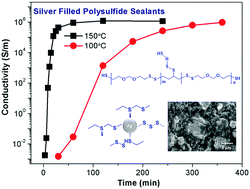Processing and characterization of silver-filled conductive polysulfide sealants for aerospace applications†
Abstract
Polysulfide (PS) rubbers have been widely used as high performance sealants to line or seal aircraft fuel tanks. However, safety concerns arise when electrostatic charges are built up due to the motion of flammable fuels. In this report, electrically conductive sealants were designed in order to dissipate these hazardous charges. Silver fillers with various sizes and surface coatings were incorporated into a polysulfide matrix to make conductive sealants. The low electrical conductivity of the sealants led to the assumption that unique filler–resin interactions occurred at their interfaces. To verify this assumption, various characterization methods were employed to investigate the chemical, thermal, morphological, electrical, and mechanical properties of the sealants. In addition, carbon fillers and other room temperature-cured polymer resins were used for comparative study. The systematic analysis revealed that the formation of coordination compounds at silver/PS interfaces could block electron conduction pathways between fillers. Based on the chemical understanding, post cure thermal annealing was utilized to break the coordinated bonds and restore high conductivity (>106 S m−1) of the sealants. Conductivity change as a function of annealing temperature and time was also explored to optimize processing conditions.



 Please wait while we load your content...
Please wait while we load your content...